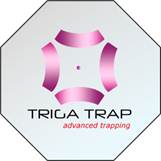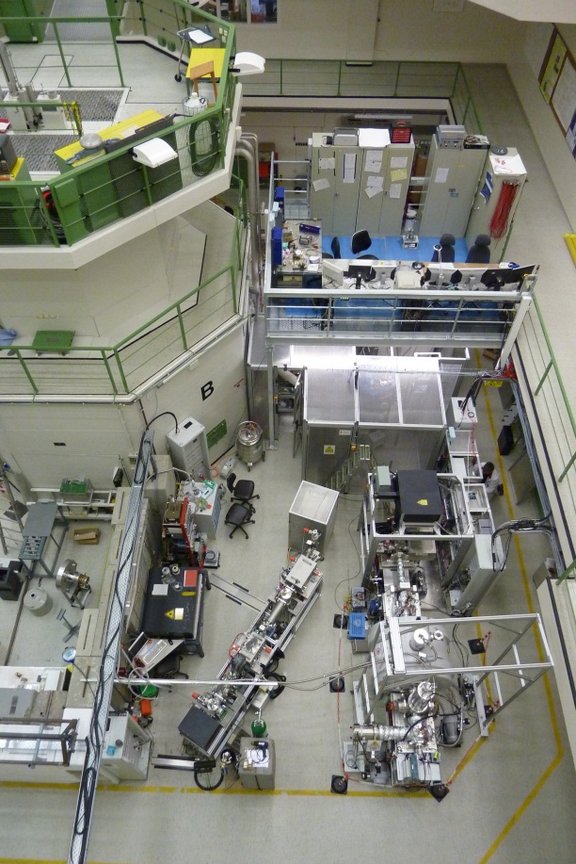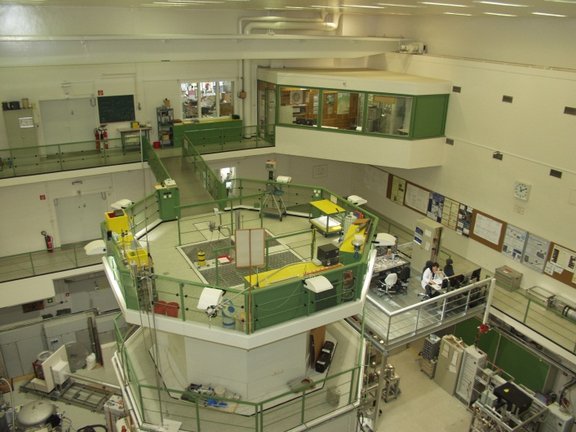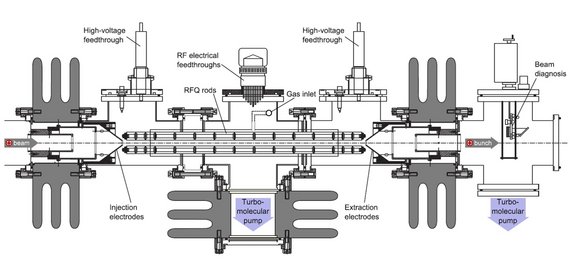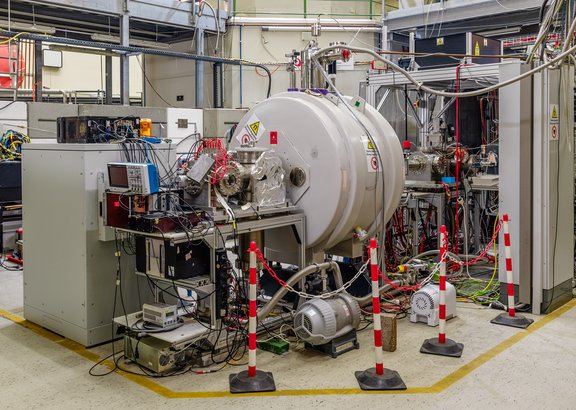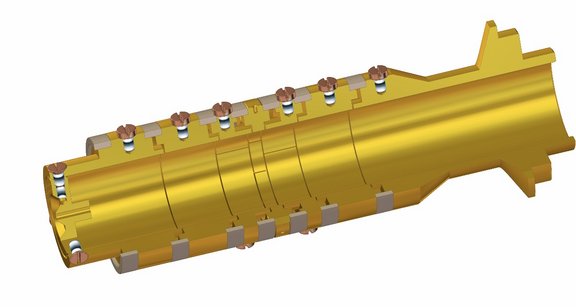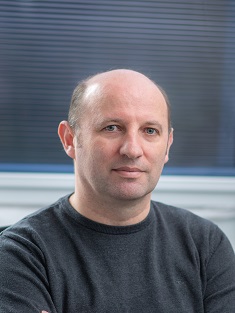TRIGA-Trap [1] is a double-Penning trap mass spectrometer at the research reactor TRIGA Mainz.
Concerning detection techniques, the setup features the commonly applied time-of-flight and phase-imaging ion cyclotron resonance methods as well as the narrow-band FT-ICR technique. Within the TRIGA-Trap project we installed for the very first time a Penning trap at a nuclear research reactor in order to have access to neutron-rich fission products. Moreover, samples of stable nuclides as well as of heavy elements above uranium are available for off-line measurements. Masses of these nuclides are of high importance among others for reliable nucleosynthesis calculations in nuclear astrophysics and for investigations of nuclear structure.
Currently a high temperature surface ion source is installed which in connection with a gas-jet transport system enables access to certain fission products [2]. For this purpose a 30 kV high voltage platform has been installed. The mass separation after the ion source is carried out by a 90° dipole magnet with a resolution of about 300. The cooler and buncher COLETTE [3], which has been transferred from CERN to TRIGA-Trap, is installed in order to prepare cooled ion bunches for the connected experiments [4].
TRIGA-Trap is one of the development platforms for the future MATS experiment within NUSTAR at FAIR. We develop and test devices and experimental procedures for MATS.
The research within the framework of the TRIGA-Trap project has close affiliations with the goals of the Extreme Matter Institute (EMMI) at GSI/Darmstadt. The institute was created by the Helmholtz Alliance "Extremes of Density and Temperature: Cosmic Matter in the Laboratory". This Alliance connects GSI with 7 national partners (among them the Max Planck Institute for Nuclear Physics at Heidelberg) as well as 4 international partners. With EMMI Europe will get a unique infrastructure for interdisciplinary investigations of matter under extreme conditions.
Applications for mass measurements with TRIGA-Trap
The chemical composition of our universe has many surprising features: Why is iron so much more abundant than heavier elements such as gold? Why are there heavy elements at all and how did they come into existence? The properties of atomic nuclei, especially their masses, play a crucial role in these fundamental questions at the interface of nuclear and astrophysics. TRIGA-Trap aims for mass measurements on neutron rich nuclei located in the least explored region of the chart of nuclides (see Figure below) that are important for the rapid neutron capture process. In addition, heavy nuclides above uranium can be studied off-line. The high- precision mass value yields the total nuclear binding energy of the nuclei relevant for nuclear structure studies since the binding energy is the result of the forces present in a nucleus.
References
| [1] | J. Ketelaer et al., Nucl. Instrum. Meth. A 594, 162-177 (2008) |
| [2] | J. Grund et al., Nucl. Instrum. Meth. A 972, 164013 (2020) |
| [3] | D. Lunney et al., Nucl. Instrum. Meth. A 598, 379-387 (2009) |
| [4] | T. Beyer et al., Appl. Phys. B 114, 129-136 (2014) |
| [5] | J. J. Cowan et al., Phys. Today 57, 47 (2004) |
The Research Reactor TRIGA Mainz
The Mainz TRIGA (Training Research Isotope General Atomics) reactor can be operated in a steady-state mode with a maximum power of 100 kWtherm or in the pulsed mode with 30 ms pulse duration (FWHM) at a peak power of 250 MWtherm. Four horizontal beam tubes give access to the strongest neutron flux near the reactor core (1.8x1011 cm-2s-1) [1]. Here, a gas-jet system is used for continuous transport of fission products from a fissionable target (U-235, Pu-239 or Cf-249) mounted close to the reactor core, through the biological shield to an ion source on a HV platform.
Gas-jet transport of the fission products
TRIGA-Trap uses an aerosol loaded gas-jet system for fission product transport, see Fig. 2. The fission products are collimated in an aerodynamical lens, ionized in a high-temperature surface ion source, accelerated, mass separated by a 90 deg. dipole magnet, cooled and bunched in a gas-filled radio-frequency quadrupole structure, decelerated in a pulsed drift-tube and transported towards the Penning-trap mass spectrometer [2].
High temperature surface ion source
Currently a high temperature surface ion source [2] is available which in connection with a gas jet transport system enables access to certain fission products. For this purpose a 30 kV HV platform has been installed. The cathode is a tantalum ionizer cylinder heated indirectly by electron bombardment from two hot filaments.
The ionizer can be heated rapidly to any temperature up to 2500 °C. The chosen temperature can be kept constant with only minor fluctuations in the range of 4 °C in 24 h. The components of the ion source are long-term stable, thus it can be operated without maintenance for two or more weeks.
Mass separator
The mass separator is a 90 deg dipole magnet with a bending radius of 0.5 m and a mass resolution of about 300. The PC controlled DANFYSIK power supply is capable of 250 A current with a stability of 10 ppm, resulting in a B-field intensity of 1.1 T. A stepper motor driven split-pair system is fitted behind the magnet.
Cooler and Buncher
COLETTE (Cooler for Emittance Elimination) is a segmented, radiofrequency quadrupole, which was designed for cooling continuous radioactive beams for injection into the MISTRAL spectrometer at CERN-ISOLDE [4]. The device has been transferred to TRIGA-Trap and it is integrated in the beam-line [5]. COLETTE transforms the continuous 30 keV beam into bunches, and cools the confined ion ensemble by buffer-gas to reduce the phase space volume.
References
| [1] | K. Eberhardt, A. Kronenberg, Kerntechnik 65, 5 (2000). |
| [2] | J. Grund et al., Nuclear Instrum. Meth. A 972, 164013 (2020) |
| [3] | M. Liehr et al., Rev. Sci. Instrum. 63, 2541 (1992) |
| [4] | D. Lunney et al., Nucl. Instrum. Meth. A 598, 379 (2009) |
| [5] | T. Beyer et al., Appl. Phys. B 114, 129-136 (2014) |
The MiniRFQ Laser Ablation Ion Source
Since the experiment is located within the controlled area of the TRIGA-Mainz research reactor, radioactive samples of sufficiently long-lived nuclides as well as of heavy elements above uranium can be measured off-line.
For off-line ion production we developed at TRIGA-Trap a novel laser ablation ion source, where the laser ablation target [1] sits in a gas-filled miniature radio-frequency quadrupole (MiniRFQ) [2].
The laser ablation process is driven by a pulsed, frequency-doubled Nd:YAG laser, which can deliver pulses with a length of 5 ns and energies of up to 12 mJ at a wavelength of 532 nm, at arepetion rate of 15 Hz.
References
| [1] | D. Renisch et al., Nucl. Instrum. Methods A 676, 84–89 (2012) |
| [2] | F. Schneider et al., Eur. Phys. J. A 51, 89 (2015) |
Fig. 1 shows the TRIGA-Trap mass spectrometer. After ionization of the nuclides of interest in the high-temperature surface ion source, mass separation in the dipole magnet as well as cooling and accumulation in the RFQ-buncher and deceleration in a pulsed drift tube, the ions are first stored in a cylindrical Penning trap for mass selective helium buffer-gas cooling in order to reduce the amplitudes of motions and for beam purification. Then the ions of interest are transferred to a high-precision Penning trap to perform the mass measurement based on the cyclotron frequency determination of the ion with charge-to-mass ratio q/m stored in the B = 7 T strong magnetic field [1].
The DLD40 MCP detector enables the application of the phase-imaging ion cyclotron resonance technique.
For the FT-ICR method an SL-quartz crystal can be connected in parallel between the trap electrodes and the electronic amplifier to improve the sensitivity of the measurement of ν+ and its frequency modulation [2].
The complete system is controlled by the LabView based CS, maintained by GSI Darmstadt and the CS Developer team. Many other Penning trap facilities also use that system and share the knowledge.
References
| [1] | K. Blaum, Phys. Rep. 425, 1-78 (2006) |
| [2] | S. Lohse et al., Rev. Sci. Instrum. 91, 093202 (2020) |
TRIGA-Trap Members
Group leaders
Prof. Dr. Klaus Blaum, Max-Planck-Institut für Kernphysik Heidelberg
Email, Tel.: +49 6221 516-851Dr. Szilard Nagy, Max-Planck-Institut für Kernphysik Heidelberg
Email, Tel.: +49 6131 39-29691
Group members
Stanislav Chenmarev, Max-Planck-Institut für Kernphysik Heidelberg
Email, Tel.: +49 6131 39-29694Tanvir Sayed, Max-Planck-Institut für Kernphysik Heidelberg
Email, Tel.: +49 6131 39-29694
Collaborators
Prof. Dr. Michael Block, Department Chemie - Standort TRIGA, Johannes Gutenberg-Universität Mainz
Dr. Klaus Eberhardt, Department Chemie - Standort TRIGA, Johannes Gutenberg-Universität Mainz
Prof. Dr. Christoph Düllmann, Institut für Kernchemie, Universität Mainz
Dr. Frank Herfurth, GSI Helmholtzzentrum für Schwerionenforschung GmbH, Darmstadt
Dr. Dennis Neidherr, GSI Helmholtzzentrum für Schwerionenforschung GmbH, Darmstadt
Prof. Dr. Wilfried Nörtershäuser, Institut für Kernphysik, Technische Universität Darmstadt
Sven Sturm, Max-Planck-Institut für Kernphysik Heidelberg
Dr. Dennis Renisch, Department Chemie - Standort TRIGA, Johannes Gutenberg-Universität Mainz
Prof. Dr. Norbert Trautmann, Department Chemie - Standort TRIGA, Johannes Gutenberg-Universität Mainz
Institutes
22Masses of transuranium nuclides measured with the PI-ICR technique at TRIGA-Trap
S. Chenmarev, K. Blaum, M. Block, R. B. Cakirli, C.. E. Düllmann, M. J. Gutiérrez, S.. Nagy, and D. Renisch
The European Physical Journal A 60, 204 (2024)
21First application of the phase-imaging ion-cyclotron resonance technique at TRIGA-Trap
S. Chenmarev, S. Nagy, J. J. W. van de Laar, K. Blaum, M. Block, and C.. E. Düllmann
European Physical Journal A 59, 29 (2023)
20Quartz resonators for penning traps toward mass spectrometry on the heaviest ions
S. Lohse, J. Berrocal, S. Böhland, J. van de Laar, M. Block, S. Chenmarev, C.. E. Düllmann, S. Nagy, J. G. Ramírez, and D. Rodríguez
Review of Scientific Instruments 91, 093202 (2020)
19First online operation of TRIGA-TRAP
J. Grund, M. Asai, K. Blaum, M. Block, S. Chenmarev, C..E. Düllmann, K. Eberhardt, S. Lohse, Y. Nagame, S. Nagy, P. Naubereit, J.J.W. van de Laar, F. Schneider, T.K. Sato, N. Sato, D. Simonovski, K. Tsukada, and K. Wendt
Nuclear Instruments and Methods in Physics Research Section A: Accelerators, Spectrometers, Detectors and Associated Equipment 972, 164013 (2020)
18Implementation of an aerodynamic lens for TRIGA-SPEC
J. Grund, C..E. Düllmann, K. Eberhardt, S. Nagy, J.J.W. van der Laar, D. Renisch, and F. Schneider
Nuclear Instruments and Methods in Physics Research Section B: Beam Interactions with Materials and Atoms 376, 225-228 (2016)
17Preparatory studies for a high-precision Penning-trap measurement of the 163Ho electron capture Q-value
F. Schneider, T. Beyer, K. Blaum, M. Block, S. Chenmarev, H. Dorrer, C..E. Düllmann, K. Eberhardt, M. Eibach, S. Eliseev, J. Grund, U. Köster, S. Nagy, Y..N. Novikov, D. Renisch, A. A.Türler, and K. Wendt
European Physical Journal A 51, 89 (2015)
16TRIGA-SPEC: the prototype of MATS and LaSpec
S. Kaufmann, T. Beyer, K. Blaum, M. Block, C..E. Düllmann, K. Eberhardt, M. Eibach, C. Geppert, C. Gorges, J. Grund, M. Hammen, J. Krämer, S.. Nagy, W. Nörtershäuser, D. Renisch, F. Schneider, and K. Wendt
Journal of Physics: Conference Series 599, 012033 (2015)
15Direct high-precision mass measurements on 241,243Am, 244Pu, and 249Cf
M. Eibach, T. Beyer, K. Blaum, M. Block, C..E. Düllmann, K. Eberhardt, J. Grund, S. Nagy, H. Nitsche, W. Nörtershäuser, D. Renisch, K.P. Rykaczewski, F. Schneider, C. Smorra, J. Vieten, M. Wang, and K. Wendt
Physical Review C 89, 064318 (2014)
14An RFQ cooler and buncher for the TRIGA-SPEC experiment
T. Beyer, K. Blaum, M. Block, C..E. Düllmann, K. Eberhardt, M. Eibach, C. Frömmgen, N. Geppert, C. Gorges, J. Grund, M. Hammen, S. Kaufmann, A. Krieger, S. Nagy, W. Nörterhäuser, D. Renisch, C. Smorra, and E. Will
Applied Physics B: Lasers and Optics 114, 129-136 (2014)
13Q value and half-life of double-electron capture in 184Os
C. Smorra, T.R. Rodríguez, T. Beyer, K. Blaum, M. Block, C..E. Düllmann, K. Eberhardt, M. Eibach, S. Eliseev, K. Langanke, G. Martínez-Pinedo, S. Nagy, W. Nörtershäuser, D. Renisch, V.M. Shabaev, I.I. Tupitsyn, and N.A. Zubova
Physical Review C 86, 044604, 1-5 (2012)
12Targets on superhydrophobic surfaces for laser ablation ion sources
D. Renisch, T. Beyer, K. Blaum, M. Block, C..E. Düllmann, K. Eberhardt, M. Eibach, S. Nagy, D. Neidherr, W. Nörtershäuser, and C. Smorra
Nuclear Instruments and Methods in Physics Research Section A: Accelerators, Spectrometers, Detectors and Associated Equipment 676, 84-89 (2012)
11Direct mass measurements of cadmium and palladium isotopes and their double-β transition Q values
C. Smorra, T. Beyer, K. Blaum, M. Block, C..E. Düllmann, K. Eberhardt, M. Eibach, S. Eliseev, S. Nagy, W. Nörtershäuser, and D. Renisch
Physical Review C 85, 027601, 1-4 (2012)
10Mass measurements on stable nuclides in the rare-earth region with the Penning-trap mass spectrometer TRIGA-TRAP
J. Ketelaer, G. Audi, T. Beyer, K. Blaum, M. Block, B. R. Cakirli, R. Casten, C. Droese, M. Dworschak, K. Eberhardt, M. Eibach, F. Herfurth, E. Minaya Ramirez, S. Nagy, D. Neidherr, W. Nörtershäuser, C. Smorra, and M. Wang
Physical Review C 84, 014311, 1-8 (2011)
9First investigation of phase-shifted Ramsey excitation in Penning trap mass spectrometry
M. Eibach, T. Beyer, K. Blaum, M. Block, K. Eberhardt, F. Herfurth, J. Ketelaer, S. Nagy, D. Neidherr, W. Nörtershäuser, and C. Smorra
International Journal of Mass Spectrometry 303, 27-30 (2010)
8Accuracy studies with carbon clusters at the Penning trap mass spectrometer TRIGA-TRAP
J. Ketelaer, T. Beyer, K. Blaum, M. Block, K. Eberhardt, M. Eibach, F. Herfurth, C. Smorra, and S. Nagy
European Physical Journal D 58, 47-52 (2010)
7Transport of fission products with a helium gas-jet at TRIGA-SPEC
M. Eibach, T. Beyer, K. Blaum, M. Block, K. Eberhardt, F. Herfurth, C. Geppert, J. Ketelaer, J. Ketter, J. Krämer, A. Krieger, K. Knuth, S. Nagy, W. Nörtershäuser, and C. Smorra
Nuclear Instruments and Methods in Physics Research A 613, 226-231 (2010)
6A broad-band FT-ICR Penning trap system for KATRIN
M. Ubieto-Diaz, D. Rodriguez, S. Lukic, S. Nagy, S. Stahl, and K. Blaum
International Journal of Mass Spectrometry 288, 1-5 (2009)
5A carbon-cluster laser ion source for TRIGA-TRAP
C. Smorra, K. Blaum, K. Eberhardt, M. Eibach, J. Ketelaer, J. Ketter, K. Knuth, and S. Nagy
Journal of Physics B 42, 154028, 1-6 (2009)
4High-accuracy Penning trap mass measurements with stored and cooled exotic ions
K. Blaum, S. Nagy, and G. Werth
Journal of Physics B 42, 154015, 1-9 (2009)
3Position-sensitive ion detection in precision Penning trap mass spectrometry
G. Eitel, M. Block, A. Czasch, M. Dworschak, S. George, O. Jagutzki, J. Ketelaer, J. Ketter, S. Nagy, D. Rodríguez, C. Smorra, and K. Blaum
Nuclear Instruments and Methods in Physics Research Section A: Accelerators, Spectrometers, Detectors and Associated Equipment 606, 475-483 (2009)
2Recent developments in ion detection techniques for Penning trap mass spectrometry at TRIGA-TRAP
J. Ketelaer, K. Blaum, M. Block, K. Eberhardt, M. Eibach, R. Ferrer, S. George, F. Herfurth, J. Ketter, S. Nagy, J. Repp, L. Schweikhard, C. Smorra, S. Sturm, and S. Ulmer
European Physical Journal A 42, 311-317 (2009)
1TRIGA-SPEC: A setup for mass spectrometry and laser spectroscopy at the research reactor TRIGA Mainz
J. Ketelaer, J. Krämer, D. Beck, K. Blaum, M. Block, K. Eberhardt, G. Eitel, R. Ferrer, C. Geppert, S. George, F. Herfurth, J. Ketter, S.. Nagy, D. Neidherr, R. Neugart, W. Nörtershäuser, J. Repp, C. Smorra, N. Trautmann, and C. Weber
Nuclear Instruments and Methods in Physics Research Section A: Accelerators, Spectrometers, Detectors and Associated Equipment 594, 162-177 (2008)
